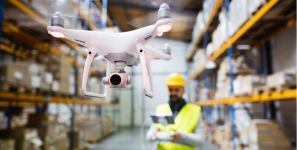Revolutionizing Warehousing: From Ancient Storage to AI-Driven Efficiency and Innovation
Introduction
The warehousing industry has undergone a remarkable transformation over the years, evolving to meet the ever-changing demands of global trade. In this article, we will explore the history of warehousing, types of warehouses, the types of products being stored today, and fundamental advances such as refrigeration, container shipping, and the rise of e-commerce. We’ll also delve into the modern era of warehousing, the role of computers and specialized software, the impact of artificial intelligence (AI), and future trends in warehouse automation.
A brief history of storage
Warehousing has a rich history dating back to ancient civilizations, when goods were stored in rudimentary facilities. The Industrial Revolution marked a turning point, with the introduction of more organized and specialized storage facilities. The arrival of the railroad and interstate highway system further revolutionized the industry by improving transportation and connectivity.
Types of Warehouses
Warehouses come in various forms, including:
- Public Warehouses: Facilities that provide storage space to multiple clients on a rental basis.
- Private Warehouses: Owned and operated by a single entity, generally for its own storage needs.
- Distribution Centers: Focused on the efficient distribution of products and order fulfillment.
- Cold Storage Warehouses: Specialized facilities for the storage of perishable and pharmaceutical products.
Types of goods that are stored today
Modern warehouses house a wide range of products, including:
- Consumer Goods: Electronics, clothing and household products.
- Perishables: Food, pharmaceutical products and medical supplies.
- Automotive Parts: Engines, tires and other components.
- E-Commerce Inventory: Products sold by online retailers.
- Industrial Equipment: Machinery, tools and raw materials.
Innovative points in storage
- Invention of Refrigeration: Refrigeration technology allowed the storage of perishable products and the expansion of the food industry.
- Oil and gas pipeline transportation: Efficient pipelines and storage facilities transformed the energy industry.
- Invention of container shipping: Standardized shipping containers revolutionized global trade by simplifying cargo handling and reducing costs.
- Rise of e-commerce: The exponential growth of online retail required adjustments in warehousing to accommodate order fulfillment, returns, and fast shipping.
The modern era of storage
Today, the storage industry relies heavily on technology and innovation. Computers and specialized software are essential to optimize storage and distribution processes. The four main types of software used in the storage industry include:
- Warehouse Management Systems (WMS) – Streamlines inventory management, order processing, and pick-and-pack operations.
- Transportation Management Systems (TMS): Facilitate efficient transportation planning and route optimization.
- Inventory Management Software – Track stock levels, replenish inventory, and reduce carrying costs.
- Supply Chain Management (SCM) Software: Improve overall supply chain efficiency and coordination.
Featured Storage Software Examples
- SAP Extended Warehouse Management (EWM): offers comprehensive warehouse and distribution management.
- Oracle Warehouse Management (WMS): Optimizes inventory and labor productivity.
- Blue Yonder (formerly JDA Software) – Provides end-to-end retail and supply chain solutions.
- Manhattan Associates: Specializes in warehouse and transportation management.
- HighJump (now part of Korber) – Offers a suite of supply chain management solutions.
Use of AI in the storage industry
Artificial Intelligence (AI) is making significant advances in warehouse industry, with usage terms including:
- Predictive analytics: AI analyzes historical data to forecast demand, allowing for better inventory management.
- Warehouse automation: AI-powered robots and autonomous vehicles improve efficiency and reduce labor costs.
- Staff training: AI-powered simulations and virtual reality help train workers more effectively.
- Shipment Tracking: AI enables real-time tracking and monitoring of goods during transportation.
Benefiting from AI service companies
AI company can help warehouses implement AI solutions. We offer expertise in AI technologies, development of custom AI models and integration into existing systems, leading to optimized operations, cost savings and increased accuracy.
Predictable future trends in automation
The future of storage will see greater automation and efficiency, with trends such as:
- Robotics: More robots and Automatically Guided Vehicles (AGVs) will help in picking, packing and transportation.
- IoT Integration: Internet of Things will provide real-time data to improve inventory and asset tracking.
- AI-driven decision making: AI will play a critical role in optimizing warehouse operations, from demand forecasting to
- Sustainability: The warehouses will focus on energy efficiency and sustainable practices to reduce their environmental footprint.
Conclusion
The warehousing industry has evolved significantly, adapting to the changing landscape of global commerce and e-commerce. Today, technology and software solutions, combined with the power of AI, are ushering in an era of efficiency, precision and innovation. As warehouses continue to automate and optimize their operations, they are prepared to meet the challenges and opportunities of the future, revolutionizing the logistics and supply chain landscape.





Leave a Reply